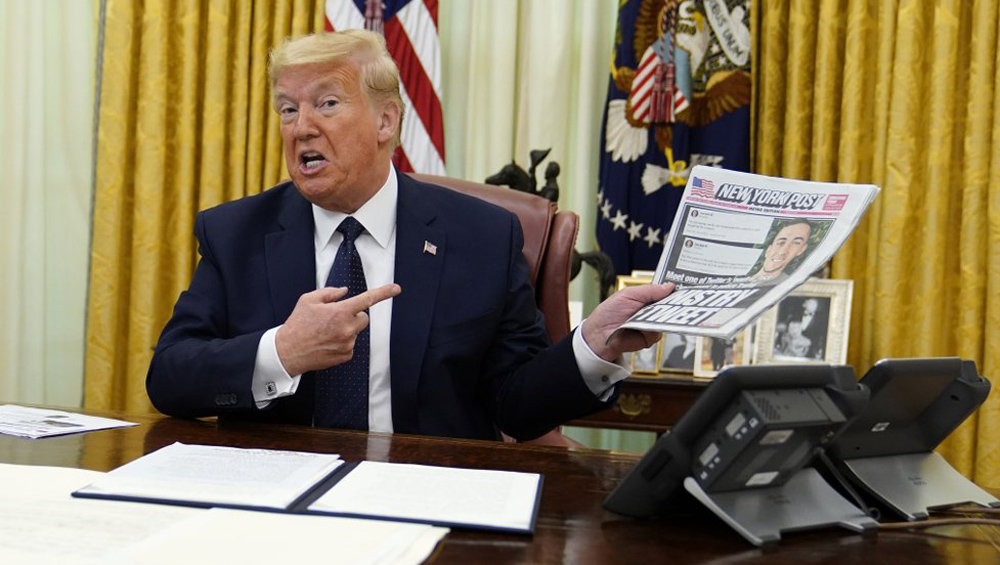
Trump Wants FCC To Join Twitter Crackdown

Stung by Twitter placing fact-check tags on his tweets earlier this week, President Trump today signed an executive order aimed at preventing Twitter and other social media from tagging as well as from censoring or otherwise regulating user content.
The order contains several directives including one calling on the FCC to establish rules that would limit how far social media can go in tampering with user content before risking the immunity they now have from libel and other civil actions arising from user content.
“We’re here today to defend free speech from one of the greatest dangers,” Trump said before signing the document.
Trump is upset with Twitter for placing fact-check labels and links on two of his tweets that asserted that mail-in ballots were fraudulent.
Ironically, he signaled his intention to issue the order yesterday via Twitter. “Republicans feel that Social Media Platforms totally silence conservative voices,” he tweeted.
“We will strongly regulate, or close them down, before we can ever allow this to happen. We saw what they attempted to do, and failed, in 2016. We can’t let a more sophisticated version of that …. happen again.”
The order expands on the tweet. “Online platforms … are engaging in selective censorship that is hurting our national discourse,” it says.
“Tens of thousands of Americans have reported, among other troubling behaviors, online platforms ‘flagging’ content as inappropriate, even though it does not violate any stated terms of service; making unannounced and unexplained changes to policies that have the effect of disfavoring certain viewpoints; and deleting content and entire accounts with no warning, no rationale, and no recourse.”
Citing a Supreme Court ruling, the order declares that it is U.S. policy that “large social media platforms like Twitter and Facebook are the functional equivalent of a traditional public forum, should not infringe on protected speech.”
Since the president has no authority over the FCC, the order instructs the Commerce Department’s National Telecommunications and Information Administration to petition the FCC to establish the social media rules within 60 days.
The force behind the Trump FCC directive is Section 230 of a federal law that protects social media from legal action stemming from user posts. The immunity is credited with helping social media to flourish.
To enjoy the immunity, social media have to refrain from interfering with posts except for “good faith” efforts to regulate “obscene, lewd, lascivious, filthy, excessively violent, harassing, or otherwise objectionable.”
In essence, Trump wants the FCC to identify social media that go beyond such good faith efforts and, by so doing, cause them to forfeit their legal immunity, the draft says.
Andrew Schwartzman, longtime FCC activist, called the FCC directives “preposterous” and “horrifying.”
“The FCC has no authority to enforce Section 230, so any interpretation it might issue will have no legal effect,” he said.
“The idea that President Trump wants to violate the First Amendment by regulating and punishing social media platforms for their editorial judgments is one more ominous sign that the rule of law is under attack.”
The executive order contains other measures.
- It prohibits executive branch agencies from buying advertising on “online platforms that violate free speech principles” by restricting speech in some fashion.
- To that end, it instructs the agencies to review within 30 days all spending on “online platforms” and ascertain their “viewpoint-based speech restrictions.”
- It directs the White House Office of Digital Strategy to collect complaints about online censorship or “potentially unfair or deceptive acts or practices” and funnel them to the Federal Trade Commission and the Department of Justice.
Based on those complaints, the draft says, FTC shall consider action against media that “restrict speech in ways that do not align with those entities’ public representations about those practices” and determine whether the complaints about “large social media platforms like Twitter” involve violation of law.
And, finally, it directs the Justice Department to convene a working group of state attorneys general that would determine whether any complaints violate state laws against unfair and deceptive practices.
































Comments (3)
tvn-member-3011604 says:
May 29, 2020 at 1:38 pm
If Twitter has to have a so-called “fact-checker” to monitor and censor the flow of tweets it receives then it is a publisher, not an impartial media platform. The president is right to take away the protections these social media platforms now enjoy. They’re no different than newspapers and broadcasters. I’m not sure if the FCC is the right agency to police these companies. This task may be better handled by the FTC who is also responsible for net neutrality enforcement among ISPs.
RIDGELINE-TV says:
May 29, 2020 at 3:23 pm
Two months to respond to a deadly epidemic, two days to respond to his tweet labeled inaccurate… Yep, our “president” has his priorities in order…
#BanRIDGELINETV says:
May 31, 2020 at 9:47 am
@RidgeLineTV: Leave Trump alone, stop accusing him of waiting to respond (he responded immediately) and leave this site now!!!!